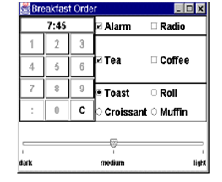Reference no: EM133296
QUESTION 1
(a)The window, as shown underneath, is an illustration of a Hotel's in-room breakfast ordering dialog.

"Breakfast Order" dialog
The client can use the TimePanel on the left-hand side to enter the time at which he/she would like his/her breakfast served up. The TimePanel can be used to enter a instance of day in the range 00:00 to 23:59. In its default state, the Time display area at the top is empty and all buttons, to one side from the C for Cancel button are available. From the default state, if the user presses any button, then the Cancel button turn into available. If the user presses the Cancel button, the interface returns to its default state. The user can also use the checkboxes at the upper right to indicate if he/she would like an alarm and/or the radio turned on at that time. The waiting checkboxes and radio buttons are used to indicate what he/she would like for breakfast. In case Toast is selected, the slider can be used to indicate the degree of toasting. The panel is dismissed by an external control and so does not need an OK button. When the Breakfast Order panel is primary shown to the user, the time is set to 0.00, the alarm and radio checkboxes are not set and coffee with medium toast is indicated.
Crucially assess the design of the "Breakfast Ordering" dialog by identifying and explaining any obvious fault(s) with it.
(b)(i) In the framework of User Interface Design, what is supposed by the term feedback?
(ii) How should response be incorporated into design of user interfaces? Make available examples to illustrate your response.
(c)(i) What is natural mapping?
(ii) Provide one instance of natural mapping and one of non-natural mapping used in GUI applications.
(d)Give details of the two types of human errors experienced by professionals as well as normal users when interacting with GUI applications. For each case, give two case in points as results of when do the errors occur.
QUESTION 2
(a)Many researches are currently being carried out in the field of web technology. One main problem
that is being addressed is the development of new parameters for web interfaces or the improvement existing ones.
(i) Why is web page design different to designing for printed media?
(ii) What are design guidelines?
(iii) Jacob Neilsen produced some design guidelines for web sites. What were three problems he covered?
(iv) What is meant by accessibility?
(v) Give three instances of how web sites can aid accessibility.
(b)Mobile phones increasingly are becoming the preferred platform for exploring the ubiquitous computing practice
(i) In what ways can the mobile phone be treated as a proxy for an individual?
(ii) Particularly, how can the mobile phone be used as a sensor that reflects properties of its owner?
(iii) What risks are exposed in this "phone as individual proxy" approach? Present specific examples of these risks, as well as potential solutions.
Many of the visions of ubiquitous computing (ubicomp) rely on context aware systems that can sense and model the states of their users, and proactively take action to relieve their users of the burden of explicit action.
(i) Express under what circumstances it might be appropriate for a system to take action autonomously.
(ii) Are there state of affairs in which taking action might not be appropriate?
(iii) What directives would you provide to interaction designers of ubicomp applications on how to approach this trouble?
QUESTION 3
(a)The origin of storyboarding for the design of applications is from the film industry.
(i) What is storyboarding and why it is significant?
(ii) What do you appreciate by "Storyboards are usually low-fidelity prototypes"?
(b)With reference to the workshop conducted in class, sketch storyboards to demonstrate how a call is initiated using a recent Nokia mobile device. Portray the behaviours of the interface and the actions of a user at the interface.
(c)Put in plain words using sketches to demonstrate the differences between the interactive interfaces of an iPhone 5 and the mobile device mentioned in (b).
QUESTION 4
(a)Mauriparadise, a prestigious hotel based in Mauritius, wishes to bring in a new service to its customers. The innovative service is rooms booking for mobile phones users. You are asked to design a mobile interface for this hotel by answering to the following enquires:
(i) What software models are you going to use?
(ii) What requirements techniques are you using?
(iii) How will you then build your interface design and what procedures are you going to use?
(iv) What issues will you take into consideration when designing the interface?
(v) Provide a sketch of the main interface(s) of the mobile booking system.
(b)An elevator panel will require buttons for four doors (parking, main door, second and third door) and for other functionalities like door open, door close, stop, and activate emergency intercom.
(i) In a single row, propose a design for these buttons.
(ii) Use the right design principles of similarity and proximity to help the user map purposes of actions.
QUESTION 5
(a)The origin of storyboarding for the design of applications is from the film industry.
(i) What is storyboarding and why it is significant?
(ii) What do you understand by "Storyboards are usually low-fidelity prototypes "?
(b)With orientation to the workshop conducted in class, sketch storyboards to demonstrate how to search for a TV
program example which day a movie will be telecasted on air and which days it will be re-telecasted of a given satellite television bouquet example Canal+, using the new HD set-top box via its remote control. Depict the behaviours of the border and the actions of a user at the interface.
(c) Assuming that you have just built a new interactive remote control, with functionalities similar to new smart phone devices example iPhone 5, Describe using sketches to express the significant differences between this new model and the one mentioned in (b).